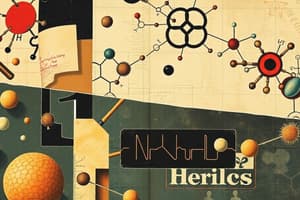Podcast
Questions and Answers
What characterizes catabolic reactions?
What characterizes catabolic reactions?
- They involve the synthesis of new enzymes.
- They occur exclusively in bioreactors.
- They require energy to produce larger products.
- They break down large substrates into smaller products. (correct)
What is the main role of bioreactors in bioprocessing?
What is the main role of bioreactors in bioprocessing?
- They act as energy sources for reactions.
- They are used to store raw materials.
- They exclusively produce enzymes.
- They facilitate enzyme reactions to create products. (correct)
How do physical methods of immobilizing enzymes differ from chemical methods?
How do physical methods of immobilizing enzymes differ from chemical methods?
- Physical methods involve bonding enzymes to supports, whereas chemical methods simply trap them.
- Chemical methods allow enzymes to be reused more easily than physical methods.
- Both methods involve enclosing enzymes in bioreactors for stability.
- Physical methods use gel to trap enzymes, while chemical methods involve bonding them to support materials. (correct)
What effect does an increase in temperature above the optimal level have on enzymes?
What effect does an increase in temperature above the optimal level have on enzymes?
Which of the following statements about enzymes is true?
Which of the following statements about enzymes is true?
Flashcards are hidden until you start studying
Study Notes
Enzyme Specificity
- Enzymes are highly specific, meaning they only react with a particular substrate.
Enzyme Reactions
- Catabolic reactions break down large substrates into smaller products, releasing energy.
- Example: Amylase breaks down starch.
- Anabolic reactions build larger products from smaller substrates, requiring energy.
- Example: Photosynthesis.
Bioprocessing & Bioreactors
- Bioprocessing uses enzyme reactions to produce products.
- Bioreactors are vessels where living organisms or their products are used to create products.
Immobilized Enzymes
- Immobilized enzymes are enzymes attached to each other or an inert material.
Metabolism
- Metabolism refers to the sum of all chemical reactions in the body.
Energy Sources
- Primary energy source is solar energy.
- Cellular energy comes from the bonds of biomolecules.
Enzymes: Structure & Function
- Enzymes are biological catalysts made of protein.
- Catalysts speed up reactions without being consumed in the process.
- Enzymes are produced by ribosomes.
- The optimal temperature for most enzymes is 37°C.
- When enzymes get too hot, they denature, changing shape and becoming inactive.
- When enzymes get too cold, they lose energy, slow down, and their activity decreases.
- The optimal pH for enzymes is generally around 7.
- Extreme pH levels can denature enzymes.
Immobilizing Enzymes
- Physical methods: Trapping enzymes in a gel.
- Chemical methods: Bonding enzymes to a support material.
Advantages of Immobilized Enzymes:
- Easier to reuse.
- More stable.
- Can remain in the bioreactor.
Uses of Immobilized Enzymes
- Converting glucose to fructose.
- Converting lactose to glucose.
Factors Affecting Enzyme Activity
- Shape: The shape of an enzyme is crucial for its function as it determines which substrate it can bind to.
- Speed: The speed at which an enzyme works is influenced by factors such as temperature and pH.
Studying That Suits You
Use AI to generate personalized quizzes and flashcards to suit your learning preferences.




